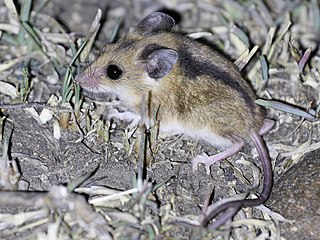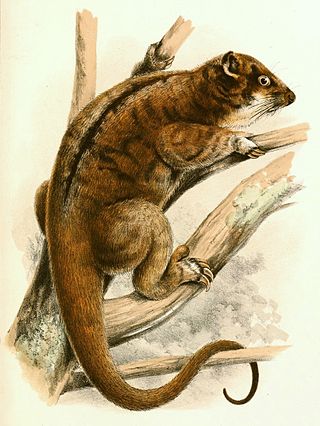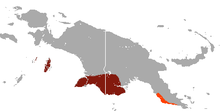
Pademelons are small marsupials in the genus Thylogale, found in Australia and New Guinea. They are some of the smallest members of the macropod family, which includes the similar-looking but larger kangaroos and wallabies. Pademelons are distinguished by their small size and their short, thick, and sparsely-haired tails. Like most other marsupials, they carry their young in a pouch.

The red-necked pademelon is a forest-dwelling marsupial living in the eastern coastal region of Australia between extreme south-east Queensland and central eastern New South Wales.

The Tasmanian pademelon, also known as the rufous-bellied pademelon or red-bellied pademelon, is the sole species of pademelon found in Tasmania, and was formerly found throughout southeastern Australia. This pademelon has developed heavier and bushier fur than its northern relatives, which inhabit northern Australia and Papua New Guinea.

The red-legged pademelon is a species of small macropod found on the northeastern coast of Australia and in New Guinea. In Australia it has a scattered distribution from the tip of Cape York Peninsula in Queensland to around Tamworth in New South Wales. In New Guinea it is found in south central lowlands.

The gray climbing mouse is a species of rodent in the family Nesomyidae. It is found in Angola, Benin, Botswana, Democratic Republic of the Congo, Ethiopia, Guinea, Liberia, Malawi, Mozambique, Namibia, Nigeria, Rwanda, South Africa, Eswatini, Tanzania, Uganda, Zambia, and Zimbabwe. Its natural habitats are dry savanna, Mediterranean-type shrubby vegetation, subtropical or tropical dry lowland grassland, and temperate desert.
Hubert's multimammate mouse, or Hubert's mastomys is a species of rodent in the family Muridae found in Burkina Faso, Gambia, Mali, Mauritania, Nigeria, and Senegal, and possibly Guinea, Guinea-Bissau, and Niger. Its natural habitats are dry savanna, subtropical or tropical seasonally wet or flooded lowland grassland, arable land, rural gardens, urban areas, irrigated land, and seasonally flooded agricultural land.

The crowned bullfrog is a species of frog in the family Dicroglossidae. It is found in the Sub-Saharan Africa . Its natural habitats are subtropical or tropical moist lowland forest, dry savanna, moist savanna, subtropical or tropical dry shrubland, subtropical or tropical moist shrubland, subtropical or tropical dry lowland grassland, subtropical or tropical seasonally wet or flooded lowland grassland, rivers, intermittent rivers, freshwater lakes, intermittent freshwater lakes, freshwater marshes, intermittent freshwater marshes, freshwater springs, arable land, pastureland, rural gardens, heavily degraded former forest, and ponds.

Ptychadena tellinii is a species of frog in the family Ptychadenidae. It is found in Burkina Faso, Cameroon, Central African Republic, Democratic Republic of the Congo, Ivory Coast, Eritrea, Ethiopia, Ghana, Mali, Nigeria, Sierra Leone, Togo, possibly Benin, possibly Chad, possibly Guinea, possibly Liberia, and possibly Sudan.

The narrow-striped dasyure or narrow-striped marsupial shrew is a species of marsupial in the family Dasyuridae found in West Papua and Papua New Guinea. Its natural habitat is subtropical or tropical dry forests.

Raffray's bandicoot is a species of marsupial in the family Peroryctidae. It is found in Indonesia and Papua New Guinea. Its natural habitat is subtropical or tropical dry forests.

The black dorcopsis or black forest wallaby is a species of marsupial in the family Macropodidae. It is endemic to an island at the eastern end of New Guinea where its natural habitat is subtropical or tropical dry forests. It is threatened by habitat loss and hunting, its population is declining and the IUCN lists it as being "Critically endangered".

The small dorcopsis or lesser forest wallaby is a species of marsupial in the family Macropodidae. It is found in the mountainous interior of West Papua and Papua New Guinea. Its natural habitat is subtropical or tropical dry forests. It is less common than it used to be and the IUCN has assessed it as being "near threatened".

The plush-coated ringtail possum or golden ringtail possum is a species of marsupial in the family Pseudocheiridae. It is found in Indonesia, Papua New Guinea, and the Solomon Islands. Its natural habitat is subtropical or tropical dry forests.

Brown's pademelon is a species of marsupial in the family Macropodidae. It is found in New Guinea. Its natural habitats are subtropical or tropical dry forests, dry savanna, subtropical or tropical dry shrubland, and subtropical or tropical dry lowland grassland. It is threatened by habitat loss.

Calaby's pademelon, also known as the alpine wallaby, is a species of marsupial in the family Macropodidae. It is endemic to Papua New Guinea. It is threatened by habitat loss and hunting.
Bocage's mole-rat is a species of rodent in the family Bathyergidae. It is found in Angola, Namibia, possibly Democratic Republic of the Congo, and possibly Zambia. Its natural habitats are subtropical or tropical dry forests, dry savanna, subtropical or tropical dry lowland grassland, and caves.

The mountain pademelon is one of seven species of the genus Thylogale. It is found only in Papua New Guinea.

The Trans Fly savanna and grasslands are a lowland ecoregion on the south coast of the island of New Guinea in both the Indonesian and Papua New Guinean sides of the island. With their monsoon and dry season climate these grasslands are quite different from the tropical rainforest that covers most of the island and resemble the landscape of northern Australia which lies to the south.

The Vogelkop–Aru lowland rain forests is a tropical moist forest ecoregion in Indonesia. The ecoregion covers the peninsular lowlands of western New Guinea, along with the Aru Islands and other nearby islands.


















